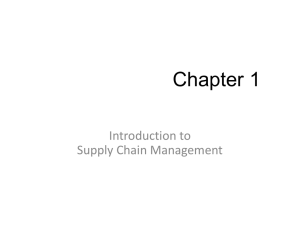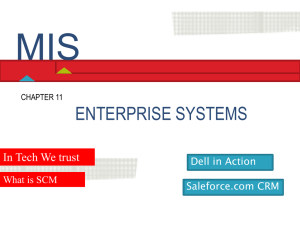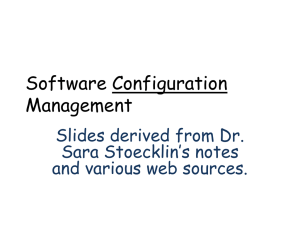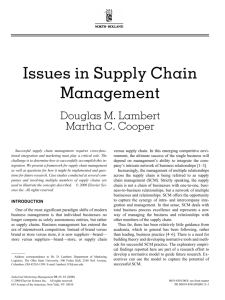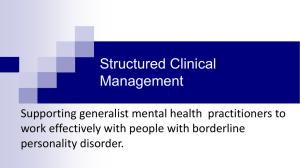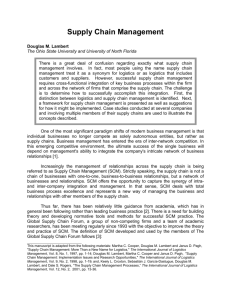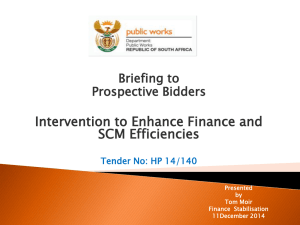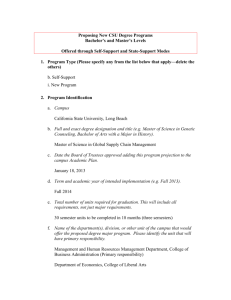Topic 4 – Introduction to Supply Chain Management (SCM)
advertisement
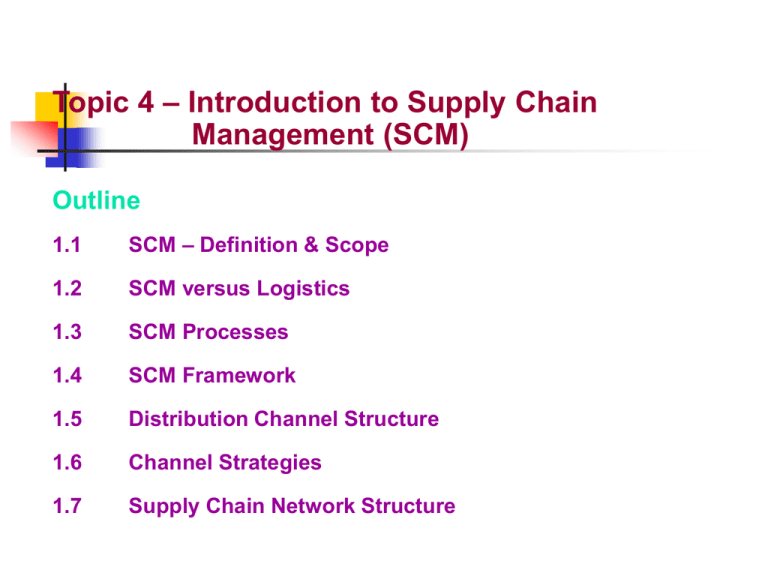
Topic 4 – Introduction to Supply Chain Management (SCM) Outline 1.1 SCM – Definition & Scope 1.2 SCM versus Logistics 1.3 SCM Processes 1.4 SCM Framework 1.5 Distribution Channel Structure 1.6 Channel Strategies 1.7 Supply Chain Network Structure 1.1 SCM – Definition & Scope Definition “The process for designing, developing, optimizing, and managing the internal and external components of the supply system, including material supply, transforming materials and distributing finished products or services to customers, that is consistent with overall objectives and strategies.” Robert E. Speckman, John W. Kamauff Jr. and Niklas Myhr, “An Empirical Investigation into Supply Chain Management”, International Journal of Physical Distribution and Logistics Management 28, no. 8 (1998), p. 631. 1.1 SCM – Definition & Scope Definition “Managing a set of three of more organizations directly linked by one or more of the upstream and downstream flows of products, services, finances, and information from a source to a customer.” J.T. Mentzer, W. DeWitt, J.S.Keebler, S. Min, N.W. Nix, C.D. Smith and Z.G. Zacharia, “A Unified Definition of Supply Chain Management,” working paper, University of Tennessee, 1999. 1.1 SCM – Definition & Scope Definition “Supply chain management is the integration of key business processes from end user through original suppliers that provides products, services, and information that add value for customers and other stakeholders. Douglas M. Lambert, Martha C. Cooper and Janus D. Pagh, “Supply Chain Management Implementation Issues and Research Opportunities”, The International Journal of Logistics Management 9, no. 2 (1998), p.1. Website: <http://www.ijlm.org> 1.1 SCM – Definition & Scope Scope: a. SCM is all about bringing products and services to the market. b. Many parties are involved in this process - from raw material suppliers and manufacturers to warehouse operators, transportation carriers, distributors and retailers. c. Managing all these supply chain members, aligning their logistics & business processes, and coordinating the sharing of related information to facilitate the accomplishment of these processes, comes under the scope of SCM. 1.2 SCM versus Logistics Logistics management is a part of SCM as illustrated in *CLM’s modified definition of logistics in 1998: “Logistics is that part of the supply chain process that plans, implements, and controls the efficient, effective flow and storage of goods, services, and related information from the point-of-origin to the point-of-consumption in order to meet customers’ requirements.” SCM has been re-conceptualized from integrating logistics across the supply chain to integrating and managing key business processes across the supply chain. *CLM = Council of Logistics Management. Website: <http://www.clm1.org> 1.3 SCM Processes Customer Relationship Management Customer Service Management Demand Management Order Fulfillment Manufacturing Flow Management Procurement Product Development & Commercialization Returns 1.3 SCM Processes SCM must also manage information flows. Information is a key enabler of supply chain integration. Product flows take place only after information flows are initiated. Figure 1 : SCM - Integrating and managing business processes across the supply chain Information flow Tier 2 supplier Tier 1 supplier Manufacturer Supply Chain Business Processes Purchasing Production Customer Consumer/ Endcustomer Logistics Marketing & sales Product Flow R&D Finance Customer relationship management Customer service management Demand management Order fulfillment Manufacturing flow management Procurement Product development & commercialization Returns Source : Douglas M. Lambert, Martha C. Cooper and Janus D. Pagh, “Supply Chain Management: Implementation Issues and Research Opportunities”, The International Journal of Logistics Management 9, no. 2 (1998), p.2. 1.4 SCM Framework Figure 2 : SCM Framework – Elements & key decisions Supply chain business processes Supply chain management components 3. What level of integration and management should be applied for each process link? Source : 2. What processes should be linked with each of these key supply chain members? Supply chain network structure 1. Who are the key supply chain members with whom to link processes? Douglas M. Lambert, Martha C. Cooper and Janus D. Pagh, “Supply Chain Management: Implementation Issues and Research Opportunities”, The International Journal of Logistics Management 9, no. 2 (1998), p.4. 1.5 Distribution Channel Structure Purpose of a distribution channel is to provide consumers with the desired combination of its outputs – lot size, delivery time, etc. - at minimal cost. Consumers determine channel structure by purchasing combinations of service outputs. The best channel is formed when no other group of institutions (members) generates more profit or more consumer satisfaction per dollar of product cost. 1.5 Distribution Channel Structure (con’t) Given a desired level of output by the consumer and competitive conditions, channel institutions (members) will arrange their functional tasks in such a way as to minimize total channel costs. Shifting of specific functions may lead to addition or deletion of channel members. Source : Bucklin, Louis P., (1966), A Theory of Distribution Channel Structure, Berkeley, C.A.:Institute of Business and Economic Research, University of California. 1.6 Channel Strategies Outsourcing a. An organization can choose to perform all logistics activities itself or use channel intermediaries, or a mix of both. b. “Make or buy” or outsourcing decisions need to address the question: Does the organization need to develop the required skills and capabilities internally, or can it be done faster and more efficiently by using a third party? 1.6 Channel Strategies Postponement a. Forms of postponement i. Postponing changes in the form and identity of a product to the last possible point in the marketing process ii. Postponing inventory location to the last possible point in time 1.6 Channel Strategies Postponement b. Postponement achieves the following: i. Reduces risk & uncertainty costs by moving product differentiation nearer to the time of purchase, when demand is more easily forecasted. ii. Reduces logistics costs by sorting products in large lots, in relatively undifferentiated states iii. Reduce inventory costs by shifting ownership of goods from one channel member to another 1.6 Channel Strategies Speculation a. By keeping speculative inventory, an organization assumes risk instead of shifting it – opposite of postponement. b. Speculation can reduce marketing costs through the following: i. Economies of large-scale production ii. Placement of large orders – reduces order processing and transportation costs iii. Reduction of stock-outs and their associated costs iv. Reduction of uncertainty c. To reduce level of speculative inventory, organizations explore time-based competitive strategies, e.g. reducing production lead-time. 1.6 Channel Strategies Time-to-Market a. Speed can be used as a competitive weapon. b. Using technology to share information among manufacturers, suppliers, customers, carriers, etc, is key to achieving speed to market Information concerning lead times, sales forecasts, production schedules, material requirements, shipping schedules, new product plans, payment, etc. 1.6 Channel Strategies Time-to-Market c. Benefits of effective time-based management: i. Enhanced customer value through better responsiveness ii. Reduced inventories due to shorter lead times iii. Reduced “cost-added” or duplicate functions iv. Improved product freshness or quality reduced handling and lower inventories v. through Improved competitive position vi. Increasing responsiveness to changing market needs vii. Improved productivity 1.7 Supply Chain Network Structure 3 primary structural aspects of a network structure: a. Members of the supply chain b. Structural elements of the network c. Different types of process links across the supply chain 1.7 Supply Chain Network Structure Identifying Supply Chain Members a. Members include all companies or organizations with whom the focal company interacts directly or indirectly through its suppliers or customers, from point-of-origin to point-ofconsumption. b. Can be categorized into primary and supporting members. i. Primary members actually perform operational and/or managerial activities in the business processes designed to produce a specific output for a particular customer or market. ii. Supporting members provide resources, utility or assets for the primary members. knowledge, c. Same company can perform both primary and supporting activities. 1.7 Supply Chain Network Structure Structural Dimensions of the Network a. Three structural elements are used to describe, analyze and manage a supply chain: i. Horizontal structure – refers to the number of tiers across the supply chain Long horizontal structure has many tiers ii. Vertical structure – refers to the number of suppliers/customers represented within each tier Narrow vertical structure has few each tier level companies at iii. Horizontal position of the focal company within the end points of the supply chain 1.7 Supply Chain Network Structure Business Process Links within the Network a. Four types of business process links can be identified between supply chain members: i. Managed process links – These are links that the focal company finds important to integrate and manage, e.g. tier 1 customers and suppliers. ii. Monitored process links – These are links that are not as critical to the focal company, e.g. process links between other members of the supply chain. However, it is important to the focal company that these are integrated and managed appropriately. Therefore, focal company monitors these. 1.7 Supply Chain Network Structure Business Process Links within the Network iii. Non-Managed process links – These are links in which the focal company is not actively involved, nor are they critical enough to use resources for monitoring. Focal company either fully trusts other members to manage the process appropriately or, because of limited resources, leaves it up to them. iv. Non-Member process links – These are process links between members of the focal company’s supply chain and non-members of the supply chain. Non-member links are not considered as links of the focal company’s supply chain structure, but they can and often will affect the performance of the focal company and its supply chain. Topic 4 Summary and Conclusion 1. Supply chain management is different from managing logistics within a supply chain. 2. Supply chain management is a process-oriented approach to managing relationships among supply chain members. 3. Managing information flows is a key element of the whole process. 4. In analyzing and making decisions on supply chain management, it is important to identify the members of the supply chain, understand the structural dimensions of the network and recognize the various business process links that exist within the network.



